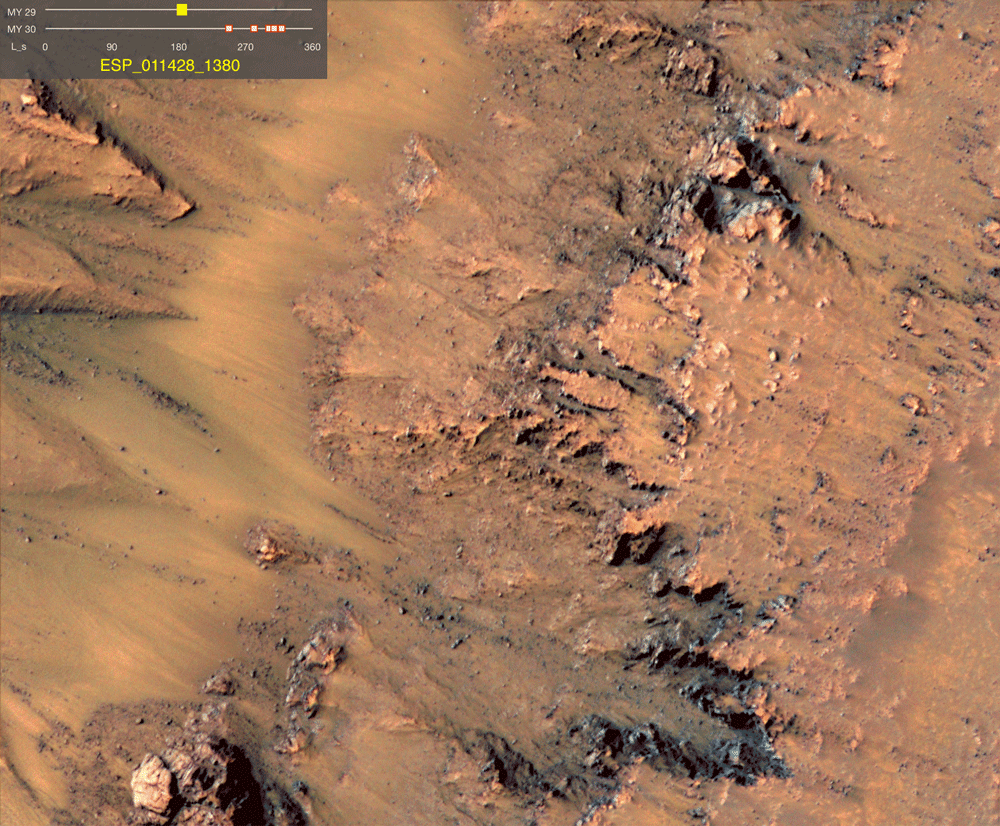
Evidence of landslides on Mars could also increase the odds that the Red Planet was once hospitable to live.
A new study, published Feb. 3 in the journal Science Advances, found that melting ice combines with the Red Planet’s salty underground permafrost, resulting in a chemical reaction that creates a “liquid-like flowing slush.” Scientists think this slush causes landslides that leave dark, narrow lines known as recurring slope line (RSL) on the surface of Mars. While the icy slush is currently too salty to harbor life, it may not have been 2 billion to 3 billion years ago, lead author of the study Janice Bishop, a senior researcher at the SETI Institute, told Live Science in an e -mail.
Scientists have been aware of the landslides for at least a decade, some of which are occurring near the Palikir and Krupac craters on Mars, Bishop said. During that time, NASA’s High Resolution Imaging Experiment (HiRISE) camera captured images of small landslides known as “depressions” and the RSLs, which it claims are characteristics of landslides.
Related: This is What NASA’s Opportunity Rover Saw Before ‘Lights Out’
Previous studies suggested that those dark lines on the surface were only related to the chemical reaction between the subsurface chlorine salts and a large amount of sulfate. The new research takes that idea and expands it with the permafrost, resulting in brine or water with a high salt concentration.
It is possible that the chemical reactions between the sulfate and salt crystals lead to expansion and migration of the salt crystals through the soil; but Bishop said this would be a “very slow process” because of the cold temperatures on Mars, which can drop to minus 80 degrees Fahrenheit (minus 62 degrees Celsius) on the surface of Mars, where the stripes are.
While the slumps and RSLs have been going on for decades, some of the images recently released by HiRISE show that changes occur in just a few months, Bishop told Live Science.
The scientists conducted laboratory experiments with sulfates, chloride salts, ice particles and volcanic ash obtained from a few Mars-like places on Earth: the McMurdo Dry Valleys in Antarctica, Israel’s Dead Sea and the Salar de Pajonales in the Atacama Desert. The mixture was frozen at temperatures similar to those on Mars (minus 58 F, or minus 50 C), before melting as soon as the temperature rose.
At cold temperatures, the chlorine salt and sulfate separate, with the ice water moving between the mixture “almost like throwing a football over the field,” resulting in soil degradation and landslides, according to one. pronunciation
Additional experiments showed a similar interaction between the sulfate and chloride moving through the Martian analagic soil.
Raina Gough, a chemistry professor at the University of Colorado, Boulder, who was not affiliated with the study, told Live Science that the new study solves the “replenishment” problem faced by other studies on Mars’ landslides; With this new find, “there is no need to top up the salts and water [or replenished] seasonal, because most of the action takes place with the brine underground. ”
The new images show that “most salt and water is not going downhill with the landslide from dry grains,” added Gough.
While Mars does not currently contain life as we know it, similar conditions have been found on Earth, particularly in Antarctica, where shrimp and other marine animals live, according to Quartz
“We don’t yet know how early habitable Mars turned into modern Mars with a harsh, cold, and dry environment,” added Bishop.
But it is possible that the environment just below the surface of the Red Planet was habitable for much longer than the surface of Mars.
Gough, whose research focuses on the formation of salt water on the Red Planet, added that it is difficult to definitively prove whether the landslides are related to salts and brine. She explained that in orbit around spacecraft the surface of Mars can only be seen from space and named two Others recent studies that may have disproved the link between RSLs and chlorine salts, as suggested by the Bishop-led study.
It’s possible these conditions may have once been life on Mars, Gough said. “There are organisms that like salt water,” but it is likely that the current conditions are “too salty to be habitable, given what we know about the limits of life on Earth.”
Next, Bishop and colleagues hope to conduct more experiments to further analyze what happens when ice grains in the Martian soils that have been mixed with a variety of different sulfates and salts are thawed.
Originally published on Live Science.